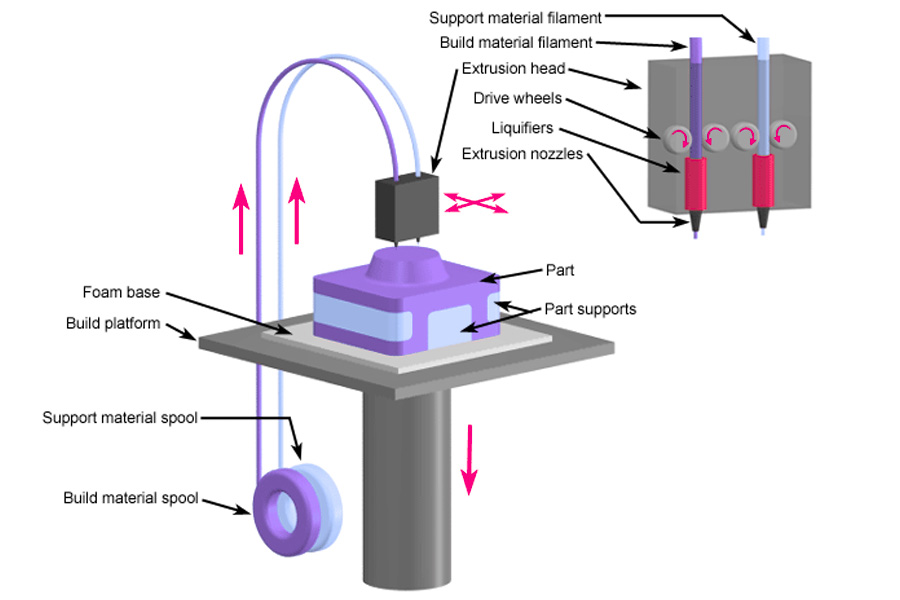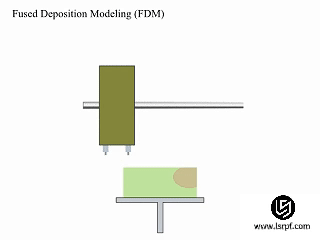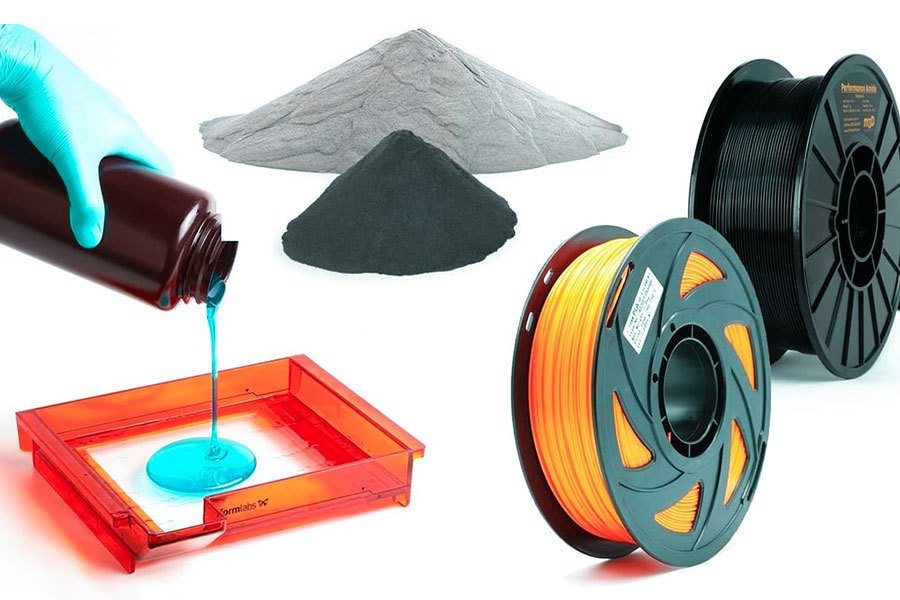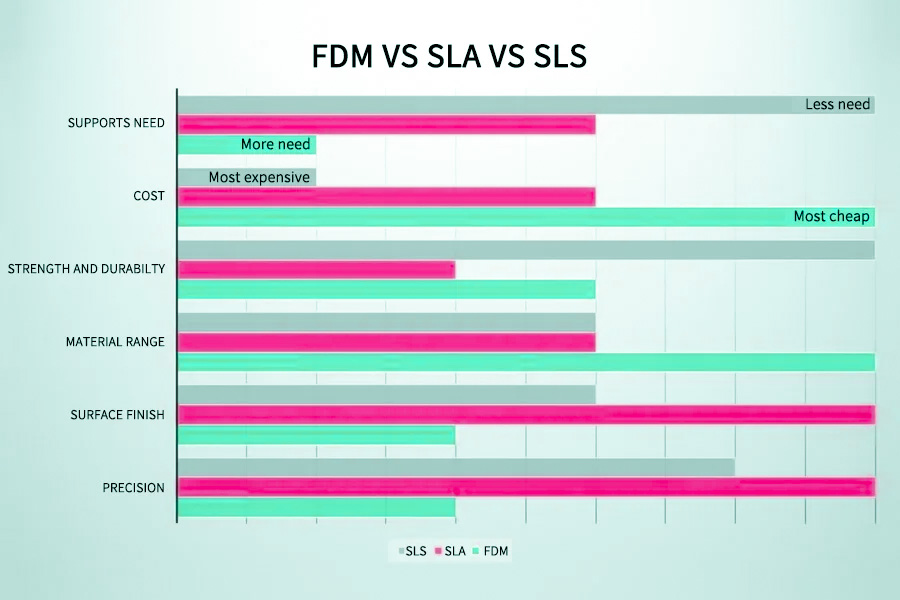Fused Deposition Modeling (FDM), also known as Fused Filament Fabrication (FFF), is currently one of the most popular and widely used 3D printing technologies. It is praised for its relatively economical cost, user-friendliness and compatibility with a wide range of materials. So, how does FDM 3D printing work? This article aims to answer your various questions.LS will lead you to delve into the basic working mechanism of fused deposition modeling, from the material preparation stage to layer-by-layer deposition to the production of the final product, showing readers a clear and comprehensive technical perspective. In addition, we will also delve into the strengths and weaknesses of FDM technology, as well as its practical application in various industries, with the goal of demonstrating how this technology can continue to promote innovation and progress in the manufacturing industry.

How Does Fused Deposition Modeling (FDM) Work?
Theworking principle of fused deposition modeling (FDM)3D printing technology is relatively simple and efficient. The following is its detailed working process:
1.Preliminary preparation:
- First, you need a3D printed modelof the target object. Before making them, these models should be divided and stitched together, and then the appropriate color or texture and other information should be selected as the rendering effect according to the needs of different scenes. The model can be designed in-house with the help of a dedicated3D modeling toolor from existing data available on the Internet.
- In the next step, we will use slicing software to convert the 3D model into a set of instructions that the 3D printer can recognize. In the slicing step, the model is horizontally divided into thin layers and a G-code file containing detailed data such as print path and extrusion speed is generated.
- In thematerial selection of FDM (fused deposition molding) printers, common printing materials are PLA, ABS, PETG and other thermoplastic filaments. In actual production, users can choose different types of plastics as printing materials according to their needs. The choice of material is based on the application environment in which the final product is located and the physical properties required.
2.About the steps for printing:
- Theprinter needsto heat the print platform and extrusion nozzle to a predetermined temperature. When the temperature is reached, the platform is heated to keep it at that temperature for a certain period of time. The heating of the platform helps to avoid warping of the model, while the heating of the nozzle ensures that the wire melts smoothly.
- During the extrusion and deposition of the material, the wire feeding system feeds the wire into a heated extruder, which is then melted and extruded inside the nozzle. The size of the nozzle is adjusted by controlling the rotation and displacement of the nozzle by the stepper motor, so that the molten material is evenly sprayed onto the mold surface.Following the instructions of the G-code,the printhead moves precisely in the X and Y axes so that the molten material settles layer by layer on the platform, thus forming the first layer of the object.
- After the first layer is deposited, the print platform lowers the height of one layer, and the print head continues to deposit the next layer of material. In this process, each layer can be reheated and cooled. Each layer is tightly blended together toform a complete 3D entity.
- During the cooling and solidification process, the molten material will quickly cool and solidify in the air to maintain its printed shape and structure.
3.Work on it later in the project:
- For models with overhangs, it may be necessary to incorporate support structures for removal during theprinting process.
- After printing, it is important to carefully remove these support structures to avoid adversely affecting the appearance of the model. After printing, the surface of the object may appear delaminated or rough textured. We can usesanding, polishing or chemical treatmenttechniques to optimize surface quality to enhance its overall aesthetics.

What Are the Advantages of FDM Printing?
FDM (Fused Deposition Modeling) printing offers the following advantages:
1.Low cost
FDM technology does not use lasers, so equipment operation and maintenance costs are low, and itsmolding materialsare mostly industrialengineering plastics such as ABS and PC, which also have low costs. Therefore, most desktop 3D printers currently use FDM technology.
2.A wide range of molding materials is available.
Through the above analysis, we know thatthermoplastic materials such as ABS, PLA, PC, and PPcan be used as molding materials for the FDM path. These are common engineering plastics, easy to obtain, and low cost.
3.Environmental pollution is less.
The entire process only involves the melting and solidification of thermoplastic materials, and is carried out in a relatively closed3D printing room. It does not involve high temperature or high pressure, and there is no emission of toxic and harmful substances. Therefore, it is highly environmentally friendly.
4.Equipment and materials are smaller in size.
3D printers using the FDM path are smaller in size, and the consumables are rolled filaments, which are easy to transport and are suitable for offices, homes and other environments.
5.High utilization rate of raw materials.
Molding materials and supporting materialsthat are not used or discarded during use can be recycled, processed and reused, which can effectively improve the utilization efficiency of raw materials.
6.Post-processing is relatively simple.
Most of the support materials currently used are water-soluble materials, which are relatively simple to peel off. Post-processing by other technical paths often requires curing and other auxiliary equipment, but FDM does not.
What Are the Limitations of FDM?
As a common 3D printing technology, FDM (fused deposition manufacturing) technology has the advantages of fast manufacturing speed, low cost, and easy operation, but it also has some limitations. The following are the mainlimitations of FDM technology:
1.The molding time is longer.
Since the movement of the nozzle is a mechanical movement, the speed during the molding process is limited, so the molding time generally takes a long time and is not suitable for manufacturing large parts.
2.Support material is required.
Support materials need to be added during the molding process, and they need to be peeled off after printing. For some complex components, there are certain difficulties in peeling off.
In addition, with the advancement of technology, some3D printing manufacturershave launched models that do not require support materials, and this shortcoming is being gradually overcome.
What materials are used in FDM printing?
FDM (Fused Deposition Manufacturing) printing mainly uses the following materials:
- ABS (acrylonitrile-butadiene-styrene copolymer):It has good strength and abrasion resistance, and is suitable for printing parts that require high strength and durability. Due to its high glass transition temperature, the parts printed byABS have good high temperature resistance. It is often used in automotive parts, home appliance housings and other fields.
- PLA (Polylactic Acid):Made from renewable cornstarch with good biodegradability. The parts printed by PLA have a smooth surface, which is suitable for printing models, artworks and other products that need to look beautiful. However, compared to ABS, PLA has lower strength and impact resistance, and may deform in high-temperature environments.
- PETG (Polyester):It has good transparency and chemical resistance, as well as high strength and toughness. It is suitable for printing functional parts that require high strength and durability, such as mechanical parts, molds, etc.
- TPU (Thermoplastic Polyurethane):An elastomer with excellent elasticity and flexibility. The parts printed by TPU have good wear resistance and tear resistance, which is suitable for printing parts that require high elasticity and durability, such as seals, rubber products, etc.
- PC (Polycarbonate):It has the characteristics of impact resistance, high toughness, high heat resistance, and chemical corrosion resistance. It is widely used in the construction industry, automobile manufacturing industry, medical equipment, aerospace, electronic appliances and other fields.
- PP (polypropylene) and simulated polypropylene materials:It is non-toxic, odorless, and its strength, stiffness, hardness, and heat resistance are higher than those of polyethylene, and can be used at about 100 °C. The simulated polypropylene material simulates the advantages of polypropylene in terms of strength and heat resistance, and at the same time makes up for the shortcomings of polypropylene in toughness and low-temperature brittleness.
- Synthetic rubber:It has high elasticity, insulation, air tightness, oil resistance, high temperature or low temperature resistance, etc. It is suitable for printing consumer electronics, medical equipment, hygiene products, car tires, and insulation.
- PPSF (Polyphenylsulfone):New engineering plastics, suitable for high-temperature working environments. It can withstand large impacts while remaining exposed to moisture and high temperatures, making it suitable for materials with high impact strength, stress cracking and chemical resistance.
- PEI (Polyetherimide):It has perfect thermal, mechanical and chemical properties, high strength, high wear resistance and dimensional stability at high temperatures. Ideal for aerospace, automotive, and military applications.

How Does FDM Compare to Other 3D Printing Methods?
FDM (Fused Deposition Manufacturing) has its own unique advantages and limitations compared with other 3D printing methods. Here is a comparison of FDM withSLA (Stereolithography), SLS (Selective Laser Sintering)and MJF (Multi Jet Fusion):
| 3D printing method | FDM (Fused Deposition Manufacturing) | SLA (Stereolithography) | SLS (Selective Laser Sintering) | MJF (Multi-Jet Fusion) |
|---|---|---|---|---|
| Technical principle | Heated nozzles melt the thermoplastic material and extrude it layer by layer | An ultraviolet laser beam irradiates a liquid photosensitive resin to cure it | The laser sinters the powder material layer by layer to form a solid | Powder bed fusion jetting technology is built layer by layer |
| Print accuracy | Medium, the layer thickness is usually between 0.1mm and 0.4mm | Height, layer thickness can be as small as 0.025mm | Moderate, the layer thickness is generally 0.1mm to 0.2mm | High, excellent detail |
| Surface | There are stripes and a staircase effect | Smooth and delicate, with excellent details | It depends on the powder particle size and sintering process | Sleek and detailed |
| Print speed | Medium, suitable for small to medium-scale production | Fast, especially for small models | Relatively slow, laser sintering and cooling | Usually faster than FDM |
| Material costs | Low, rich in materials | Higher, special resins are expensive | Medium to high, depending on powder type | May be reduced due to material utilization |
| Equipment costs | Lower, easy to popularize | Higher | Medium to high | Probably higher than FDM devices |
| Material adaptability | Thermoplastic filament | Photosensitive resin | Powder materials (nylon, metal, etc.) | Powder Material |
| Strength & Performance | Moderate, depending on the material | Depends on the type of resin | Usually taller and suitable for high-strength parts | Generally good with excellent mechanical properties |
| Fields of application | Education, Rapid Prototyping, Manufacturing | High-precision model making (jewelry, medical) | Manufacture of high-strength, complex structural parts | High precision, fast production and good mechanical properties for application |

Summary
As a widely used 3D printing technology, fused deposition modeling (FDM) has shown strong applicationpotential and value in many fields such as product design, prototyping, and education. By understanding how it works, its key elements, and how to optimize it, we can better leverage this technology to meet different application needs. At the same time, it is also necessary to recognize thelimitations of FDM technologyand consider and solve them in practical applications.
Disclaimer
The content on this page is for reference only.LSdoes not make any express or implied representation or warranty as to the accuracy, completeness or validity of the information. No performance parameters, geometric tolerances, specific design features, material quality and type or workmanship should be inferred as to what a third party supplier or manufacturer will deliver through the Longsheng Network. It is the responsibility of the buyerseeking a quote for partsto determine the specific requirements for those parts.Pleasecontact usfor moreinformation.
LS Team
LS is an industry-leading companyspecializing in custom manufacturing solutions. With over 20 years of experience serving more than 5,000 clients, we focus on high-precisionCNC machining,sheet metal fabrication,3D printing,injection molding,metal stamping,and other one-stop manufacturing services.
Our factory is equipped with more than 100 advanced 5-axis machining centers and is ISO 9001:2015 certified. We provide fast, efficient, and high-quality manufacturing solutions to customers in over 150 countries worldwide. Whether it’s low-volume production or large-scale customization, we can meet your needs with delivery as fast as 24 hours. ChoosingLS Technologymeans choosing efficiency, quality, and professionalism.
To learn more, please visit our website:www.lsrpf.com
FAQs
1.What is the process of fused deposition modeling?
The process of fused deposition modeling (FDM) is to feed thermoplastic materials (such as ABS, PLA, etc.) into the 3D printer in the form of filaments. The filaments are melted in a heated nozzle and deposited layer by layer on the build platform according to preset 3D model data. After each layer is deposited, the material quickly cools and solidifies to form a solid part. As the build platform descends layer by layer (or the nozzle ascends layer by layer), the entire process repeats until the entire object is completely printed.
2.What is fused deposition modeling used for?
FDM technology is widely used in many fields due to its low cost, easy operation and easy availability of materials. It is mainly used for prototyping to help designers and engineers quickly verify the feasibility and functionality of product designs. In addition, FDM is also used in manufacturing and custom parts production, such as auto parts, aerospace components, medical equipment, etc. Because it can be customized according to needs, it is also widely used in the fields of art creation and education.
3.How does FDM work?
The working principle of FDM is based on the melting and layer-by-layer deposition of thermoplastic materials. During the printing process, a heated nozzle melts the thermoplastic filament and extrudes the molten filament through a computer-controlled path onto the build platform. The filaments quickly cool and solidify upon contact with the platform, forming a layer of the object. As the nozzle moves and the platform descends layer by layer (or the nozzle ascends layer by layer), this process repeats until the entire object is completely printed.
4.Why is FDM the most popular 3D printing technology currently?
FDM is currently the most popular 3D printing technology, mainly because it combines low cost, ease of use, material diversity, and a wide range of applications, making it easy for individual users, small and medium-sized enterprises, and educational institutions to adopt and benefit from this technology.
Resource
2.Surface Modification of 3D Printed PLA Objects by Fused Deposition Modeling: A Review
3.Polyvinyl alcohol reinforced with carbon nanotubes for fused deposition modeling







